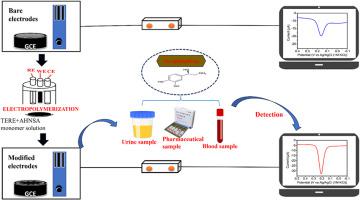当前位置:
X-MOL 学术
›
Mater. Chem. Phys.
›
论文详情
Our official English website, www.x-mol.net, welcomes your feedback! (Note: you will need to create a separate account there.)
A Surfactant-Electropolymer modified dual sensor for the monitoring of norepinephrine at nanomolar levels in biological samples and pharmaceutical formulations
Materials Chemistry and Physics ( IF 4.6 ) Pub Date : 2024-04-04 , DOI: 10.1016/j.matchemphys.2024.129266 M.G. Gopika , Bhama Sajeevan , Aswathy S. Murali , Sree lekshmi , Mani Govindasamy , Beena Saraswathyamma
Materials Chemistry and Physics ( IF 4.6 ) Pub Date : 2024-04-04 , DOI: 10.1016/j.matchemphys.2024.129266 M.G. Gopika , Bhama Sajeevan , Aswathy S. Murali , Sree lekshmi , Mani Govindasamy , Beena Saraswathyamma

|
This paper focuses on the surface modification of a Glassy carbon electrode (GCE) using poly-terephthalic acid and poly-4-amino-3-hydroxy-1-naphthalenesulfonic acid (poly-(TERE-AHNSA)/GCE) by simultaneous electropolymerization of respective monomers for the first time from the best of our knowledge, which is a simple and cost-effective method. FTIR, AFM, and SEM-EDX examinations were used to confirm the developed electrode. The adapted electrode is then used for the monitoring and determination of clinically significant norepinephrine (NE) using electroanalytical techniques such as differential pulse and cyclic voltammetry. The electrooxidation of NE on poly-(TERE-AHNSA)/GCE occurred at a potential of +0.216 V in phosphate buffer solution (PB) of pH 6.0 and showed a higher current response compared to electrodes developed with separate electropolymers. This enhanced response is likely due to the synergistic effect of both polymer layers obtained through electropolymerization, which increases the surface area. The developed sensor exhibits favorable characteristics, including a lowest detection limit (LOD) of 2.08 nM, a linear range spanning from 5.0 nM to 1600.0 μM which is the widest range ever reported, as well as improved sensitivity and selectivity, surpassing previous reports. The linearity analysis was also performed utilizing a screen-printed electrode (SPE), yielding linear ranges of 100.0 nM–600.0 μM. With a recovery rate ranging from 98 to 105%, the developed sensor shows great potential as a reliable tool for electroanalysis of NE in blood, urine, and pharmaceutical samples.
中文翻译:

表面活性剂-电解质改性双传感器,用于监测生物样品和药物制剂中纳摩尔水平的去甲肾上腺素
本文重点研究了使用聚对苯二甲酸和聚-4-氨基-3-羟基-1-萘磺酸(聚-(TERE-AHNSA)/GCE)通过同时电聚合对玻碳电极(GCE)进行表面改性。据我们所知,这是一种简单且经济有效的方法,首次对各个单体进行了分离。使用 FTIR、AFM 和 SEM-EDX 检查来确认所开发的电极。然后,采用微分脉冲和循环伏安法等电分析技术,将改造后的电极用于监测和测定具有临床意义的去甲肾上腺素 (NE)。在 pH 6.0 的磷酸盐缓冲溶液 (PB) 中,聚 (TERE-AHNSA)/GCE 上的 NE 电氧化发生在 +0.216 V 的电位下,与使用单独的电聚合物开发的电极相比,显示出更高的电流响应。这种增强的响应可能是由于通过电聚合获得的两个聚合物层的协同效应,这增加了表面积。所开发的传感器表现出良好的特性,包括2.08 nM的最低检测限(LOD)、从5.0 nM到1600.0 μM的线性范围(这是迄今为止报道的最宽的范围),以及改进的灵敏度和选择性,超越了之前的报道。还利用丝网印刷电极 (SPE) 进行线性分析,产生 100.0 nM–600.0 μM 的线性范围。所开发的传感器的回收率范围为 98% 至 105%,显示出作为血液、尿液和药物样品中 NE 电分析的可靠工具的巨大潜力。
更新日期:2024-04-04
中文翻译:

表面活性剂-电解质改性双传感器,用于监测生物样品和药物制剂中纳摩尔水平的去甲肾上腺素
本文重点研究了使用聚对苯二甲酸和聚-4-氨基-3-羟基-1-萘磺酸(聚-(TERE-AHNSA)/GCE)通过同时电聚合对玻碳电极(GCE)进行表面改性。据我们所知,这是一种简单且经济有效的方法,首次对各个单体进行了分离。使用 FTIR、AFM 和 SEM-EDX 检查来确认所开发的电极。然后,采用微分脉冲和循环伏安法等电分析技术,将改造后的电极用于监测和测定具有临床意义的去甲肾上腺素 (NE)。在 pH 6.0 的磷酸盐缓冲溶液 (PB) 中,聚 (TERE-AHNSA)/GCE 上的 NE 电氧化发生在 +0.216 V 的电位下,与使用单独的电聚合物开发的电极相比,显示出更高的电流响应。这种增强的响应可能是由于通过电聚合获得的两个聚合物层的协同效应,这增加了表面积。所开发的传感器表现出良好的特性,包括2.08 nM的最低检测限(LOD)、从5.0 nM到1600.0 μM的线性范围(这是迄今为止报道的最宽的范围),以及改进的灵敏度和选择性,超越了之前的报道。还利用丝网印刷电极 (SPE) 进行线性分析,产生 100.0 nM–600.0 μM 的线性范围。所开发的传感器的回收率范围为 98% 至 105%,显示出作为血液、尿液和药物样品中 NE 电分析的可靠工具的巨大潜力。



























 京公网安备 11010802027423号
京公网安备 11010802027423号